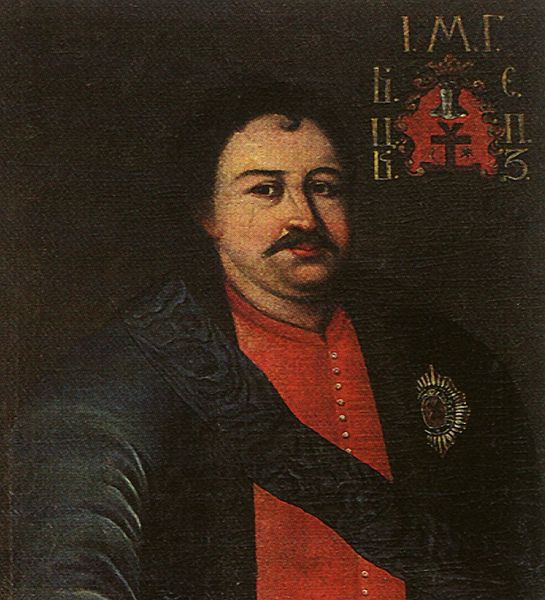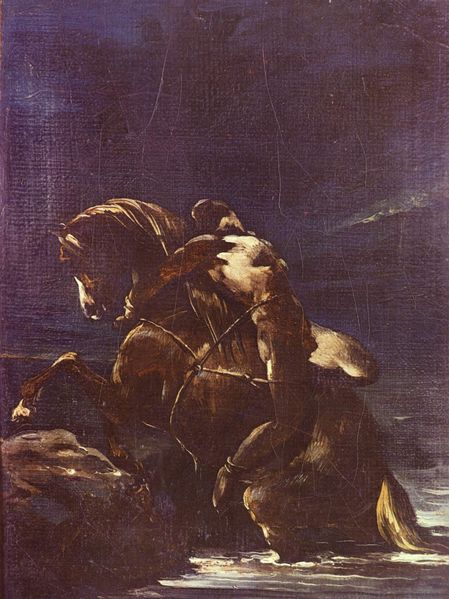<Back to Index>
- Mathematician Sergei Petrovich Novikov, 1938
- Sculptor Jean Antoine Houdon, 1741
- Hetman of Ukraine Ivan Stepanovych Mazepa, 1639
PAGE SPONSOR

Ivan Stepanovych Mazepa (Ukrainian: Іван Степанович Мазепа; 20 March 1639 — 2 October 1709), Cossack Hetman of the Hetmanate in Left-bank Ukraine, in 1687 – 1708. He was famous as a patron of the arts, and also played an important role in the Battle of Poltava.
Mazepa was likely born March 20, 1639 in Mazepyntsi, near Bila Tserkva, then a part of the Polish-Lithuanian Commonwealth, into a noble Ukrainian family. His mother was Maryna Mokievska, and his father was Stefan Adam Mazepa. He was educated first in the Kyiv-Mohyla Academy, then at a Jesuit college in Warsaw and abroad. From 1659 he served at the court of the Polish king, John II Casimir.
In 1669 – 1673, Mazepa served under Hetman Petro Doroshenko, and in 1674 – 1681, under Hetman Ivan Samoylovych. A young educated Mazepa quickly rose through the Cossack ranks and in 1682 – 1686, he served as a General-Yesaul. In 1687, Ivan Mazepa accused Samoylovych of conspiring to secede from Russia, secured his ouster and was elected the Hetman of the Left-bank Ukraine, with the support of Vasily Galitzine's Russian government. Gradually,
Mazepa accumulated great wealth, becoming one of Europe's largest land
owners. A multitude of churches were built all over Ukraine during his
reign in the Ukrainian Baroque style. He expanded the Kyiv-Mohyla Academy,
the primary educational institution of Ukraine at the time, to
accommodate 2,000 students, founded schools and printing houses.
In 1702, the Cossacks of Right-bank Ukraine, under the leadership of hetman Semen Paliy, began an uprising against Poland, which after early successes was defeated. Mazepa convinced Russian Tsar Peter I to allow him to intervene, which he successfully did, taking over major portions of Right-bank Ukraine, while Poland was weakened by invasion of Swedish king Charles XII.
In the beginning of the 18th century, as the Russian Empire suffered setbacks in the Great Northern War,
Peter I decided to reform the Russian army and to centralize control
over his realm. In Mazepa's opinion, the strengthening of Russia's
central power could put at risk the broad autonomy granted to the Cossack Hetmanate under the Treaty of Pereyaslav in
1654. Attempts to assert control over the Zaporozhian Cossacks included
demands of having them fight in any of the tsar's wars, instead of just
defending their own land against regional enemies as was agreed to in
the treaty. Now Cossack forces had to fight in distant wars in Livonia and Lithuania, instead of protecting their own homes from the Tatars and Poles.
Unequipped and not properly trained to fight on par with the modern
European armies, Cossacks suffered heavy losses and low morale, as
their commanders were Russians and Germans who often did not value
their lives or their specific military abilities. The population of
Ukraine had to bear the presence of the Russian army, which was accused
of disrespectful behaviour and looting in Ukrainian cities where it was
stationed. The
Hetman himself started to feel his post threatened in the face of
increasing calls to replace him with one of the abundant generals of
the Russian army. The
last straw in the souring relations with Tsar Peter was his refusal to
commit any significant force to defend Ukraine against the Polish King Stanislaus Leszczynski, an ally of Charles XII of Sweden, who threatened to attack the Cossack Hetmanate in
1708. Peter expected that king Charles of Sweden was going to attack
and decided he could spare no forces. In the opinion of Mazepa, this blatantly violated the Treaty of Pereyaslav,
since Russia refused to protect Ukraine's territory and left it to fare
on its own. As the Swedish and Polish armies advanced towards Ukraine,
Mazepa allied himself with them on October 28, 1708. However, only
3,000 Cossacks followed their Hetman, with the rest remaining loyal to the
Tsar. Mazepa's call to arms was further weakened by the Orthodox Clergy's allegiance for the Tsar. Learning of Mazepa's treason, the Russian army sacked and razed the Cossack Hetmanate capital of Baturyn,
killing most of the defending garrison and many common people. The
Russian army was ordered to tie up the dead Cossacks to crosses, and
float them down the Dnieper River all the way to the Black Sea. This was done for the purpose of intimidating the Mazepa loyalists who lived downstream along the Dnieper. Those Cossacks who did not side with Mazepa elected a new hetman, Ivan Skoropadsky,
on November 11, 1708. The fear of other reprisals and suspicion of
Mazepa's newfound Swedish ally prevented most of Ukraine's population
from siding with him. Surprisingly, the only significant support which
he gathered came from the Zaporizhian Sich,
which, though at odds with the Hetman in the past, considered him and
the nobility he represented a lesser evil compared with the Tsar. The
Sich Cossacks paid dearly for their support of Mazepa, as Peter I
ordered the Sich to be razed in 1709 and a decree was issued to execute
any active Zaporizhian Cossack.
The
Swedish and Russian armies spent the first half of 1709 maneuvering for
advantage in the anticipated great battle, and trying to secure the
support of the local populace. Finally in June the Battle of Poltava took
place. It was won by Russia, putting an end to Mazepa's hopes of
transferring Ukraine into the control of Sweden, which in a treaty had
promised independence to Ukraine. Mazepa fled with Charles XII to the Turkish fortress of Bendery, where Mazepa soon died. Mazepa's
decision to abandon his allegiance to the Russian Empire was considered
treason by the Russian Tsar and a violation of the Treaty of Pereyaslav.
However others argue that it was Imperial Russia who broke the treaty,
because it failed to even try to protect the Cossack homeland while
busy fighting abroad while Ukrainian peasants had complained about the
conduct of local Muscovite troops, Cossacks had died while building Saint Petersburg and the Tsars planned to deploy Cossack troops far from their homeland. The image of a disgraceful traitor persisted throughout Russian and Soviet history. The Russian Orthodox Church illegally anathemaised and excommunicated him
for political reasons. Until 1869 his name was even added to the list
of traitors publicly cursed in Russian churches during the Feast of Orthodoxy service, along with Pugachev, Razin and False Dmitry I. Later on a positive view of Mazepa was taboo in the Soviet Union and considered as a sign of "Ukrainian bourgeois nationalism". During the years of Perestroika, however, many historical works saw light which viewed Mazepa differently. After Ukraine's independence in 1991, Mazepa was proclaimed a national hero in Ukraine's official historiography and mainstream media,
because he was the first post-Pereyaslav Treaty hetman to take a stand
against the Tsar, who failed to ratify that Treaty. This view however
is still disputed by pro-Russian factions. According to an April 2009 survey by the Research & Branding Group 30
percent of the population of Ukraine views Mazepa as "a man who fought
for the independence of Ukraine", while 28 percent view him "as a
turncoat who joined the enemy's ranks". During an event in Mazepyntsi to mark the 370th birthday (March 20, 2009) of Hetman Mazepa, President Viktor Yushchenko called
for the myth about the alleged treason of Mazepa to be dispelled.
According to Yushchenko the hetman wanted to create an independent Ukraine and architecture was thriving in Ukraine over the years of Mazepa's rule, "Ukraine was reviving as the country of European cultural traditions". The
same day around a hundred people held a protest in Simferopol against
the marking of the 370th birthday of Mazepa. The protesters held
posters with slogans as: "Dog Mazepa, damn you and your ideological
followers!", "Eternal shame on the sickly Judas - Ivashka Mazepa and
his followers!" and "Ukraine's future is in alliance with Russia". They
also held flags of Russia, as well as portraits of Russian President Dmitry Medvedev, Russian Prime Minister Vladimir Putin, and Russian Emperor Peter the Great. In May 2009 the Russian foreign ministry stated
in an answer to Ukraine's preparations to mark the 300th anniversary of
the battle of Poltava and plans to erect a monument to Mazepa that
those where attempts at an "artificial, far-fetched confrontation with
Russia. We would like to remind the leaders of Ukraine that playing
games with history, especially with hidden nationalist motives, has
never led to any good." Mazepa's portrait is found on the 10 hryvnia (Ukrainian currency) bill. Late August 2009 Ukrainian President Viktor Yushchenko demanded the resuming of a halted construction of an Ivan Mazepa monument in Poltava. A monument to Mazepa will be erected on Slava Square in Kiev in 2010 to fulfill a decree of Yushchenko. After researching his genealogy in 2009 (then) President of Ukraine Viktor Yushchenko did not rule out that his family is connected with the family of Ivan Mazepa. In August, 2009, a monument to the hetman was unveiled in Chernihiv.
